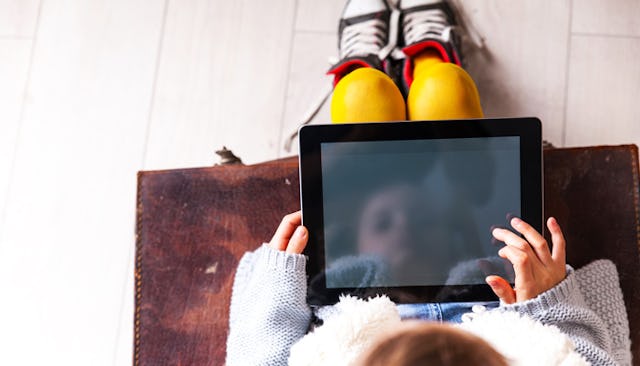Once And For All, Is The iPad Good Or Bad For Kids?

My 5-year-old is obsessed with the iPad. I’ve put a couple of games on there for him, but what he mainly likes is the voice dictation software. He speaks slowly and carefully into the mic, and the software writes his story: “I am could you please type that could you please type out I am a pirate.” He begs for the iPad; he adores the iPad. I wish I’d never introduced it to him.
Now I have a 2-year-old, and he now knows the iPad is something marvelous and forbidden as well. He also grabs it whenever we inadvertently leave it by the bedside or on our desks. He already knows how to swipe to unlock it.
Everyone knows the AAP recommended no screen time for kids under 2 and not more than two hours a day for kids over 2 until just recently. But what I didn’t know is that those recommendations were established before interactive apps became a thing, especially a thing for babies and toddlers. Are, perhaps, interactive apps “better” for kids than just passive screen watching? [She asked, hopefully.]
Because while I feel a stab of guilt every time I hand a kid my phone or the iPad, it’s usually because I have to do something—like fill out papers at the DMV or get a mole check from the dermatologist—that isn’t kid-friendly, and I’m short on child care that day. The iPad may be only reason I have a driver’s license and a clean bill of health from the derm. I hope it’s not doing them too much harm, because dammit, I need it.
But yeah, about the guilt. No one has really been studying the effects of different kinds of screen time on kids. Is mesmerizing them with Sesame Street better or worse than mesmerizing them with an interactive app? As Johanna Lee reports in ArsTechnica, that kind of research is only in its infancy, largely because 1) interactive apps change so quickly; 2) it’s difficult to design lab studies that precisely duplicate real-world apps marketed to children; and 3) it’s tough to find kids to participate in studies. (Busy parents don’t really want to drag their kids to labs and have them videotaped, for no pay.)
But nonetheless, Dr. Heather Kirkorian, an assistant professor in the Human Development and Family Studies Department at the University of Wisconsin-Madison, is on the case, reports Lee.
First, a quick primer on why the iPad is so attractive to small children, even more so than the television. Interactive software exploits children’s love of “contingency”: If they do something—Lee gives an example of chucking toys on the floor—and you pick up the toys, they will be delighted and continue chucking their toys on the floor. Interactive software is this times a million. If they swipe and the iPad turns on, if they tap an app and it launches, they are fascinated.
Kirkorian studies whether contingency helps children learn more than passive watching alone does. She found that for young 2-year-olds, interacting with the app helped them learn. But for kids 30 months or older, they learned just as well from a video as from an interactive program. Lee writes: “This finding in particular has important implications. Engaging children to actively participate and interact with the screen may overcome the notorious video deficiency effect. Perhaps children under two years old can learn from screens after all.”
But she’s quick to point out that there are caveats. For one, a lab study doesn’t necessarily reflect the real world. What apps our kids are using might be mesmerizing without actually teaching them anything. We may buy our kids apps that are too easy or difficult, and so they have no learning value at all. In general, children learn best from in-person interactions, so researchers stressed that parents should monitor the way kids are using the technology rather than using it as a digital babysitter. Lee writes “[a] tablet should thus be used as a tool to increase interaction with your kid instead of a replacement for interaction.”
Er, okay. But that doesn’t solve the dermatologist scenario, or the filling-out-paperwork-at-the-DMV scenario, or even the I-need-20-minutes-to-cook-dinner scenario. I guess the best I can do is be scrupulous ahead of time about researching the best apps for my kids, and deploy them judiciously. It’s a relief to know that not all screen time is created equal, and when you’re really up a creek—or in a gown a the doctor’s—well, there’s an app for that.
This article was originally published on